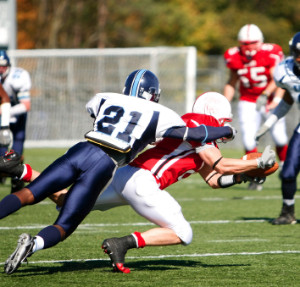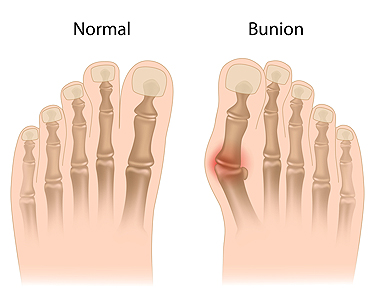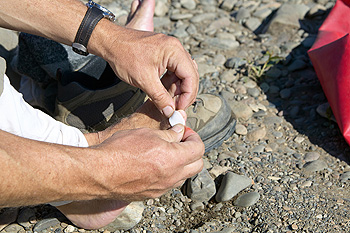Rheumatoid arthritis (RA) is an autoimmune disorder that causes the body’s immune system to attack the lining of the joints. This leads to joint pain, as well as weakened tendons and ligaments. RA often affects the joints of the feet and ankles, especially in the early stages of the disease. Symptoms of this condition include painful, swollen, and stiff joints. Over time, RA can also change the position of joints, leading to misalignment and a decrease in joint function and range of motion. The earlier RA is detected and diagnosed, the earlier treatment can begin. Early treatment can prevent RA symptoms from worsening. If you have RA and experience foot and ankle symptoms, it is suggested that you are under the care of a podiatrist, who can help you manage this condition and stay on your feet.
Because RA affects more than just your joints, including the joints in your feet and ankles, it is important to seek early diagnosis from your podiatrist if you feel like the pain in your feet might be caused by RA. For more information, contact one of our podiatrists of Advanced Ankle & Foot Surgeons. Our doctors will assist you with all of your podiatric concerns.
What Is Rheumatoid Arthritis?
Rheumatoid Arthritis (RA) is an autoimmune disorder in which the body’s own immune system attacks the membranes surrounding the joints. Inflammation of the lining and eventually the destruction of the joint’s cartilage and bone occur, causing severe pain and immobility.
Rheumatoid Arthritis of the Feet
Although RA usually attacks multiple bones and joints throughout the entire body, almost 90 percent of cases result in pain in the foot or ankle area.
Symptoms
Diagnosis
Quick diagnosis of RA in the feet is important so that the podiatrist can treat the area effectively. Your doctor will ask you about your medical history, occupation, and lifestyle to determine the origin of the condition. Rheumatoid Factor tests help to determine if someone is affected by the disease.
If you have any questions please feel free to contact our office located in O'Fallon, IL . We offer the newest diagnostic and treatment technologies for all your foot and ankle needs.
 Corns and calluses occur due to friction or pressure on the feet. While calluses are usually asymptomatic and cover a broader area of skin, corns are deeper, more focused and more painful. Corns are usually pea-sized, have a plug, and extend deep into the surface of the skin. Calluses tend to stay closer to the surface, without a plug. Treatment options for both include manual removal, cushioning the affected area, and adjusting biomechanics, such as changing your shoes. Patients who frequently have issues with corns and calluses should consult with a podiatrist for proper preventative measures and various treatment options.
Corns and calluses occur due to friction or pressure on the feet. While calluses are usually asymptomatic and cover a broader area of skin, corns are deeper, more focused and more painful. Corns are usually pea-sized, have a plug, and extend deep into the surface of the skin. Calluses tend to stay closer to the surface, without a plug. Treatment options for both include manual removal, cushioning the affected area, and adjusting biomechanics, such as changing your shoes. Patients who frequently have issues with corns and calluses should consult with a podiatrist for proper preventative measures and various treatment options.
If you have any concerns regarding your feet and ankles, contact one of our podiatrists of Advanced Ankle & Foot Surgeons. Our doctors will treat your foot and ankle needs.
Corns: What Are They? and How Do You Get Rid of Them?
Corns can be described as areas of the skin that have thickened to the point of becoming painful or irritating. They are often layers and layers of the skin that have become dry and rough, and are normally smaller than calluses.
Ways to Prevent Corns
There are many ways to get rid of painful corns such as wearing:
Treating Corns
Treatment of corns involves removing the dead skin that has built up in the specific area of the foot. Consult with Our doctors to determine the best treatment option for your case of corns.
If you have any questions please feel free to contact our office located in O'Fallon, IL . We offer the newest diagnostic and treatment technologies for all your foot and ankle needs.
 The Lisfranc joint complex is composed of the five metatarsal bones, plus the tendons and ligaments that form the arch at the top of the foot. When the ligaments or tendons become sprained or the metatarsal bones get fractured, a Lisfranc injury occurs. The injury most commonly occurs when the foot is twisted while falling. These situations are common in sports such as football, when the foot is stepped on, twisted while pointing, or stepped on while facing down. Signs of a Lisfranc injury include swelling, tenderness, and pain at the top of the foot, and bruising may be present on the bottom of the foot as well. If you believe you are suffering from a Lisfranc injury, a podiatrist will need to examine the foot and possibly take X-rays in order to give a proper diagnosis. Common treatment methods include immobilization, ice and elevation, therapy, and in severe cases, surgery may be necessary.
The Lisfranc joint complex is composed of the five metatarsal bones, plus the tendons and ligaments that form the arch at the top of the foot. When the ligaments or tendons become sprained or the metatarsal bones get fractured, a Lisfranc injury occurs. The injury most commonly occurs when the foot is twisted while falling. These situations are common in sports such as football, when the foot is stepped on, twisted while pointing, or stepped on while facing down. Signs of a Lisfranc injury include swelling, tenderness, and pain at the top of the foot, and bruising may be present on the bottom of the foot as well. If you believe you are suffering from a Lisfranc injury, a podiatrist will need to examine the foot and possibly take X-rays in order to give a proper diagnosis. Common treatment methods include immobilization, ice and elevation, therapy, and in severe cases, surgery may be necessary.
Sports related foot and ankle injuries require proper treatment before players can go back to their regular routines. For more information, contact one of our podiatrists of Advanced Ankle & Foot Surgeons. Our doctors can provide the care you need to keep you pain-free and on your feet.
Sports Related Foot and Ankle Injuries
Foot and ankle injuries are a common occurrence when it comes to athletes of any sport. While many athletes dismiss the initial aches and pains, the truth is that ignoring potential foot and ankle injuries can lead to serious problems. As athletes continue to place pressure and strain the area further, a mild injury can turn into something as serious as a rupture and may lead to a permanent disability. There are many factors that contribute to sports related foot and ankle injuries, which include failure to warm up properly, not providing support or wearing bad footwear. Common injuries and conditions athletes face, including:
Sports related injuries are commonly treated using the RICE method. This includes rest, applying ice to the injured area, compression and elevating the ankle. More serious sprains and injuries may require surgery, which could include arthroscopic and reconstructive surgery. Rehabilitation and therapy may also be required in order to get any recovering athlete to become fully functional again. Any unusual aches and pains an athlete sustains must be evaluated by a licensed, reputable medical professional.
If you have any questions please feel free to contact our office located in O'Fallon, IL . We offer the newest diagnostic and treatment technologies for all your foot and ankle needs.
 Bunions are a joint misalignment that occur as bony bumps at the base of the big toe, and they can be extremely painful. Bunions tend to form over time and cause the big toe to bend towards the other toes. Bunions can be caused by pressure on the forefoot, wearing poorly fitted shoes, including high heels, or trauma to the foot. Biomechanical factors such as overpronation of the foot can also lead to bunions. Treating a bunion will involve reducing pain and correcting any biomechanical issues. While orthotics are often recommended, surgery may be needed for more severe cases. If you are suffering from a bunion, consult with a podiatrist for proper treatment.
Bunions are a joint misalignment that occur as bony bumps at the base of the big toe, and they can be extremely painful. Bunions tend to form over time and cause the big toe to bend towards the other toes. Bunions can be caused by pressure on the forefoot, wearing poorly fitted shoes, including high heels, or trauma to the foot. Biomechanical factors such as overpronation of the foot can also lead to bunions. Treating a bunion will involve reducing pain and correcting any biomechanical issues. While orthotics are often recommended, surgery may be needed for more severe cases. If you are suffering from a bunion, consult with a podiatrist for proper treatment.
If you are suffering from bunion pain, contact one of our podiatrists of Advanced Ankle & Foot Surgeons. Our doctors can provide the care you need to keep you pain-free and on your feet.
What Is a Bunion?
Bunions are painful bony bumps that usually develop on the inside of the foot at the joint of the big toe. As the deformity increases over time, it may become painful to walk and wear shoes. Women are more likely to exacerbate existing bunions since they often wear tight, narrow shoes that shift their toes together. Bunion pain can be relieved by wearing wider shoes with enough room for the toes.
Causes
Symptoms
In order to diagnose your bunion, your podiatrist may ask about your medical history, symptoms, and general health. Your doctor might also order an x-ray to take a closer look at your feet. Nonsurgical treatment options include orthotics, padding, icing, changes in footwear, and medication. If nonsurgical treatments don’t alleviate your bunion pain, surgery may be necessary.
If you have any questions, please feel free to contact our office located in O'Fallon, IL . We offer the newest diagnostic and treatment technologies for all your foot care needs.
 If you are a runner, then you are likely not a stranger to blisters. Most blisters are caused by the repetitive friction of your shoes rubbing against the skin of your foot. Blisters can be painful and may make it difficult to continue running. Fortunately, there are multiple things that you can do to prevent blisters. Make sure that you run in properly fitted, supportive running shoes and socks that are made specifically for running. If there are areas of your feet that are prone to developing blisters while you run, you can place moleskin bandage, pads, or athletic tape over them. If you have calluses on your feet, you may want to keep them, as they can actually protect your feet from blistering while you run. For more information about preventing blisters and other foot and ankle injuries, consult with a podiatrist today.
If you are a runner, then you are likely not a stranger to blisters. Most blisters are caused by the repetitive friction of your shoes rubbing against the skin of your foot. Blisters can be painful and may make it difficult to continue running. Fortunately, there are multiple things that you can do to prevent blisters. Make sure that you run in properly fitted, supportive running shoes and socks that are made specifically for running. If there are areas of your feet that are prone to developing blisters while you run, you can place moleskin bandage, pads, or athletic tape over them. If you have calluses on your feet, you may want to keep them, as they can actually protect your feet from blistering while you run. For more information about preventing blisters and other foot and ankle injuries, consult with a podiatrist today.
Blisters are prone to making everyday activities extremely uncomfortable. If your feet are hurting, contact one of our podiatrists of Advanced Ankle & Foot Surgeons. Our doctors can provide the care you need to keep you pain-free and on your feet.
Foot Blisters
Foot blisters develop as a result of constantly wearing tight or ill-fitting footwear. This happens due to the constant rubbing from the shoe, which can often lead to pain.
What Are Foot Blisters?
A foot blister is a small fluid-filled pocket that forms on the upper-most layer of the skin. Blisters are filled with clear fluid and can lead to blood drainage or pus if the area becomes infected.
How Do Blisters Form?
Blisters on the feet are often the result of constant friction of skin and material, usually by shoe rubbing. Walking in sandals, boots, or shoes that don’t fit properly for long periods of time can result in a blister. Having consistent foot moisture and humidity can easily lead to blister formation.
Prevention & Treatment
It is important to properly care for the affected area in order to prevent infection and ease the pain. Do not lance the blister and use a Band-Aid to provide pain relief. Also, be sure to keep your feet dry and wear proper fitting shoes. If you see blood or pus in a blister, seek assistance from a podiatrist.
If you have any questions, please feel free to contact our office located in O'Fallon, IL . We offer the newest diagnostic and treatment technologies for all your foot care needs.